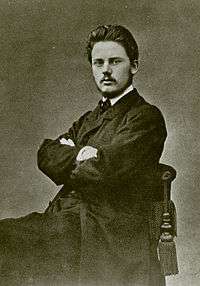Gustaf de Laval
| Gustaf de Laval | |
|---|---|
|
Gustaf de Laval 1875 | |
| Born |
9 May 1845 Orsa, Dalarna |
| Died |
2 February 1913 (aged 67) Stockholm |
| Nationality | Swedish |
| Alma mater | Institute of Technology in Stockholm |
| Known for | Steam turbines and dairy machinery |
|
Signature | |
Karl Gustaf Patrik de Laval (9 May 1845 – 2 February 1913) was a Swedish engineer and inventor who made important contributions to the design of steam turbines and dairy machinery.
Life

Gustaf de Laval was born at Orsa in Dalarna in the Swedish de Laval Huguenot family. He enrolled at the Institute of Technology in Stockholm (later the Royal Institute of Technology, KTH) in 1863, receiving a degree in mechanical engineering in 1866, after which he matriculated at Uppsala University in 1867.
He was then employed by the Swedish mining company, Stora Kopparberg. From there he returned to Uppsala University and completed his doctorate in 1872. He was further employed in Kloster Iron works in Husby parish, Sweden.[1]
Gustaf de Laval was a member of the Royal Swedish Academy of Sciences from 1886. He was a successful engineer and businessman. He also held the national office, being elected to Swedish parliament, from 1888 to 1890 and later became a member of senate. De Laval died in Stockholm in 1913 at the age of 67.[1]
Contributions
de Laval nozzle
In 1882 he introduced his concept of an impulse steam turbine[2] and in 1887 built a small steam turbine to demonstrate that such devices could be constructed on that scale. In 1890 Laval developed a nozzle to increase the steam jet to supersonic speed, working off the kinetic energy of the steam, rather than its pressure. The nozzle, now known as a de Laval nozzle, is used in modern rocket engine nozzles. De Laval turbines can run at up to 30,000 rpm. The turbine wheel was mounted on a long flexible shaft, its two bearings spaced far apart on either side. The higher speed of the turbine demanded that he also designed new approaches to reduction gearing, which are still in use today. Since the materials available at the time were not strong enough for the immense centrifugal forces, the output from the turbine was limited and large scale electric steam generators were dominated by designs using the alternative compound steam turbine approach of Charles Parsons.[2]
Using high pressure steam in a turbine that had oil-fed bearings meant that some of the steam contaminated the lube-oil, and as a result, perfecting commercial steam-turbines required that he also develop an effective oil/water separator. After trying several methods, he concluded that a centrifugal separator was the most affordable and effective method. He developed several types, and their success established the centrifugal separator as a useful device in a variety of applications.
De Laval cream separators and Alfa Laval
De Laval also made important contributions to the dairy industry, including the first centrifugal milk-cream separator and early milking machines, the first of which he patented in 1894. It was not until after his death, however, that the company he founded marketed the first commercially practical milking machine, in 1918. Together with Oscar Lamm, de Laval founded the company Alfa Laval in 1883, which was known as AB Separator until 1963 when the present name was introduced.
DeLaval
In 1991, Alfa Laval Agri, a company producing dairy and farming machinery was split from Alfa Laval when it was bought by the Tetra Pak Group. When Alfa Laval was sold, Alfa Laval Agri remained a part of the Tetra Pak group and was renamed DeLaval, after the company's founder.
Image gallery Gustaf de Laval
 Gustaf de Laval at the age around 50.
Gustaf de Laval at the age around 50. Impulse Turbine by Gustaf de Laval. Built in Sweden, 1888. Deutsches Museum, Munich.
Impulse Turbine by Gustaf de Laval. Built in Sweden, 1888. Deutsches Museum, Munich. A unique submarine invented by Gustaf de Laval[3]
A unique submarine invented by Gustaf de Laval[3] The former De Laval steam turbine factory in Nacka outside Stockholm, now converted to a conference centre.
The former De Laval steam turbine factory in Nacka outside Stockholm, now converted to a conference centre.
He is interred at Norra begravningsplatsen in Stockholm, Sweden.[4]
See also
References
- 1 2 Anderson.J.D,Modern compressible flow,Mcgraw Hills,third edition.
- 1 2 Vaclav Smil (2005). Creating the Twentieth Century: Technical Innovations of 1867-1914 and Their Lasting Impact. Oxford University Press. p. 62. ISBN 0-19-516874-7. Retrieved 2009-01-03.
- ↑
- ↑ Gustaf de Laval at Find a Grave
External links
| Wikimedia Commons has media related to Gustaf de Laval. |
| Wikisource has original works written by or about: Gustaf de Laval |
- Alfa Laval - Official site
- DeLaval - Official site
- DeLaval - Unofficial site
